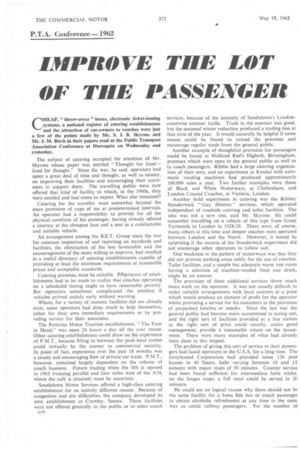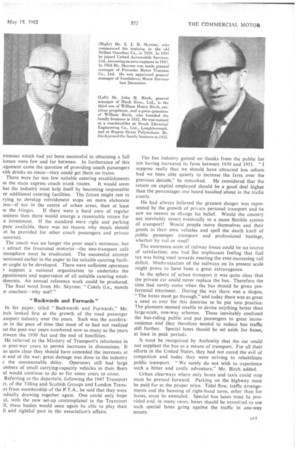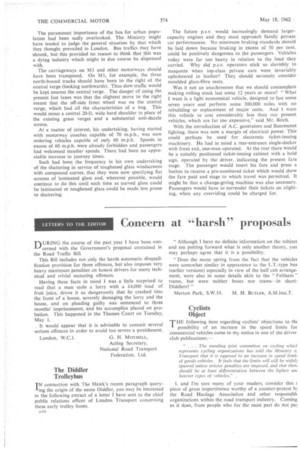P.T.A. Conference-1%2
Page 60

Page 65

Page 66

If you've noticed an error in this article please click here to report it so we can fix it.
IMPROVE THE LOT OF THE PASSENGER
CHEAP, " throw-away " buses, electronic ticket-issuing systems, a national register of catering establishments and the attraction of car-owners to coaches were just a few of the points made by Mr. S. J. B. Skyrme and Mr. J. M. Birch in their papers read at the Public Transport Association Conference at Harrogate on Wednesday and yesterday.
The subject of catering occupied the attention of Mr. Skyrme whose paper was entitled "Thought for food— food for thought." Since the war, he said, operators had spent a great deal of time and thought, as well as money, on improving their facilities and encouraging their customers to support them. The travelling public were now offered that kind of facility to which, in the 1960s, they were entitled and had come to expect. What else remained?
Catering for the traveller went somewhat beyond the mere provision of cups of tea at predetermined intervals. An operator had a responsibility to provide for all the physical comforts of his passenger, having already offered a journey at the cheapest fare and a seat in a comfortable and suitable vehicle.
An arrangement among the B.E.T. Group since the war for. constant inspection of and reporting on standards and facilities, the elimination of the less favourable and the encouragement of the more willing to improve, had resulted in a useful directory of catering establishments capable of providing at least the minimum requirements at reasonable prices and acceptable standards.
Catering premises must be suitable. Hoprietors of establishments had to be made to realize that coaches operating on a scheduled timing ought to have reasonable priority. But operators sometimes complicated the position if vehicles arrived unduly early without warning.
Where, for a variety of reasons, facilities did not already exist, some operators had done much to help themselves, either for their own immediate requirements or by providing service for their associates.
The Potteries Motor Traction establishment, "The Four in Hand," was open 24 hours a day all the year round. Other catering establishments could draw on the experience of P.M.T., because filling in between the peak-hour rushes could virtually be the answer to commercial security. In point of fact, experience over the past 18 months was a steady and encouraging flow of private car trade. P.M.T., however, remained largely dependent on the volume of coach business. Future trading when the M6 is opened in 1963 (running parallel and four miles west of the A34, where the cafe is situated) must be uncertain.
Southdown Motor Services offered a high-class catering establishment for an entirely different reason. Because of congestion and site difficulties, the company developed its own establishment at Crawley, Sussex. These facilities were not offered generally to the public or to other coach n t 0 services, because of the intensity of Southdown's Londoncoastwise summer traffic. Trade in the summer was good, but the seasonal winter reduction produced a trading loss at that time of the year. It would naturally be helpful if some means could be found to extend the premises and encourage regular trade from the general public.
Another example of thoughtful provision for passengers could be found at Midland Red's Digbeth, Birmingham, premises which were open to the general public as well as to coach passengers. Ribble had a large catering organization of their own, and an experiment at Kendal with automatic vending machines had produced approximately 160,000 sales a year. Two further examples were those of Black and White Motorways, at Cheltenham, and London Coastal Coaches, at Victoria, London.
Another bold experiment in catering was the Ribble/ Standerwick "Gay Hostess" services, which operated independent of roadside catering and toilet facilities. The idea was not a new one, said Mr: Skyrme. He could remember travelling on a vehicle of this type from Great Yarmouth to London in 1928-29. There were, of course, many others at this time and sleeper coaches were operated between London and the North. However, it would be surprising if the success of the Standerwick experiment did not encourage other operators to follow suit.
One weakness in the pattern of motorways was that they did not provide parking areas solely for the use of coaches. Toilet facilities, and a simple but adequate warm rest room having a selection of machine-vended food and drink, might be an answer.
The provision of these additional services threw much more work on the operator. It was not usually difficult to make suitable arrangements with local caterers at a price which would produce an element of profit for the operator whilst providing a service for his customers in the provision of prepacked lunches or snacks. Since the last war the general public had become more accustomed to eating out, and the right sort of facilities provided at a bus station at the right sort of price could usually, under good management, provide a reasonable return on the investment. There were many examples of what had already been done in this respect.
The problem of giving this sort of service to their passengers had faced operators in the U.S.A. for a long time. The Greyhound Corporation had provided some 136 post houses in 40 States, halts varying between 10 and 15 minutes with major stops of 30 minutes. Counter service had been found sufficient for intermediate halts whilst, on the longer stops, a full meal could be served in 20 minutes.
He could see no logical reason why there should not be the same facility for a 'bona fide bus or coach passenget to obtain alcoholic refreshment at any time in the same way as could railway passengers. Yet the number ol 'remises which had yet been successful in obtaining a full icence were few and far between. In furtherance of this trgument came the question of providing coach passengers vith drinks en route—they could get them on trains.
There were far too few suitable catering establishments on the main express coach. trunk routes. It would seem hat the industry must help itself by becoming responsible or additional catering facilities. The future might rest in rying to develop refreshment stops on more elaborate nes—if not in the centre of urban areas, then at least Pri the fringes. If there were a hard core of regular ■ usiness then there would emerge a reasonable return for n investment. If the standard were right and parking pace available, there was no reason why meals should ot be provided for other coach passengers and private aotorists.
The coach was no longer the poor man's motorcar, but ) attract the frustrated motorist—the neo-transport cafe tmosphere must be eradicated. The successful attempt -ientioned earlier in the paper Lb list suitable catering facilies ought to be developed. There were sufficient operators 3 support a national organization to undertake the ppointment and supervision of all suitable catering estabstments. An annual reference work could be produced. The final word from Mr. Skyrme: " Cote's (i.e., motels )1coaches)—why not?"
"Backwards and Forwards"
In his paper, titled "Backwards and Forwards," Mr. irch looked first at the growth of the road passenger ansport industry over the years. Such was the acceleram in the pace of time that most of us had not realized kat the post-war years numbered now as many as the years etween the 1930 Act and the end of hostilities.
He referred to the Ministry of Transport's reluctance in le post-war years to permit increases in dimensions. It as quite clear they should have conceded the increases at ie end of the war; great damage was done to the industry
the unreasonable delay. Operators still had large imbers of small carrying-capacity vehicles in their fleets id would continue to do so for some years to come. Referring to the departure, following the 1947 Transport ct, of the Tilling and Scottish Groups and London Transnt from membership of the P.T.A., he said that they were .adually drawing together again. One could only hope at, with the new set-up contemplated in the Transport ;11, these bodies would once Again be able to play their 11 and rightful part in the association's affairs.
The bus industry gained no thanks from the public for not having increased its fares between 1939 and 1951. "1 suppose really that we should have attracted less odium had we been able quietly to increase the fares over the previous decade," he remarked. He considered that the return on capital employed should be a good deal higher than the percentages one heard bandied about in the traffic courts.
He had always believed the greatest danger was represented by the growth of private personal transport and he saw no reason to change his belief. Would the country not inevitably revert eventually to a more flexible system of transport? Would people move themselves and their goods in their own vehicles and spelt the death knell of public passenger transport and professional haulage, whether by rail or road?
The enormous scale of railway losses could be no source of satisfaction; one had the unpleasant feeling that fuel tax was being used towards meeting the ever-increasing rail deficit. Modernization of the railways on its present scale might prove to have been a great extravagance.
In the sphere of urban transport it was quite clear that the private car could never replace the bus. Therefore the time had surely come when the bus should be given preferential treatment. During the war there was a slogan, "The buses most go through," and today there was as great a need as ever for this doctrine to be put into practice. The planners seemed unable to devise anything better than large-scale, one-way schemes. These inevitably confused the bus-riding public and put passengers to great inconvenience and they therefore tended to reduce bus traffic still further. Special lanes should be set aside for buses, at least in peak period;.'
It must be recognized by Authority that the car could not supplant the bus as a means of transport. For all their efforts in the United States, they had not cured the evil of congestion and today they were striving to rehabilitate public transport. " We surely do not wish to experience such a bitter and costly adventure," Mr. Birch added.
Urban clearways where only buses and taxis could stop must be pressed forward. Parking on the highway must be paid for at the proper price. Tidal flow, traffic arrangements and the banning of right-hand turns, other than for buses, must be extended. Special bus lanes must be provided and, in many cases, buses should be permitted to use such special lanes going against the traffic in one-way streets. The paramount importance of the bus for urban population had been sadly overlooked. The Ministry might have tended to judge the general situation by that which they thought prevailed in London. Bus traffics may have shrunk, but this provided no reason to think that this was a dying industry which might in due course be dispensed with.
The carriageways on M1 and other motorways should have been transposed. On Ml, for example, the three north-bound tracks should have been to the right of the central verge (looking northwards). Thus slow traffic would be kept nearest the central verge. The danger of using the present fast lanes was that the slightest move to the right meant that the off-side front wheel was on the central verge, which had all the characteristics of a bog. This would mean a central 20-ft. wide hard shoulder in place of the existing grass verges and a substantial anti-dazzle screen.
At a matter of interest, his undertaking, having started with motorway coaches capable of 70 m.p.h., was now ordering vehicles capable of only 60 m.p.h. Speeds in excess of 60 m.p.h. were already forbidden and passengers had welcomed steadier speeds. There had been no appreciable increase in journey times.
Such had been the frequency in his own undertaking of the shattering in service of toughened glass windscreens with compound curves, that they were now specifying flat screens of laminated glass and, wherever possible, would continue to do this until such time as curved glass could be laminated or toughened glass could be made less prone to shattering. The future p.s.v. would increasingly demand largercapacity engines and they must approach family private car performances. No minimum braking standards should be laid down because braking in excess of 50 per cent. could be positively dangerous to the passengers. Vehicles today were far too heavy in relation to the load they carried. Why did p.s.v. operators stick so slavishly to moquette when top-class private cars were invariably upholstered in leather? They should seriously consider moulded glass-fibre seats.
Was it not an anachronism that we should contemplate making rolling stock last some 12 years or more? "What I want is a light economical vehicle, designed to last some seven years and perform some 300,000 miles with no rebuilding or replacement of major units. And I want this vehicle to cost considerably less than our present vehicles, which are far too expensive," said Mr. Birch.
With the introduction of A.C. generators and fluorescent lighting, there was now a margin of electrical power. This could perhaps be used for electronic ticket-issuing machinery. He had in mind a rear-entrance single-decker with front exit, one-man operated. At the rear there would be a suitably positioned ticket-issuing cabinet with a bold sign, operated by the driver, indicating the present fare stage. The passenger would insert his fare and press a button to receive a pre-numbered ticket which would show the fare paid and stage to which travel was permitted. It might be that a change-giving machine was also necessary. Passengers would have to surrender their tickets on alighting, when any overriding could be charged for.




















































































































